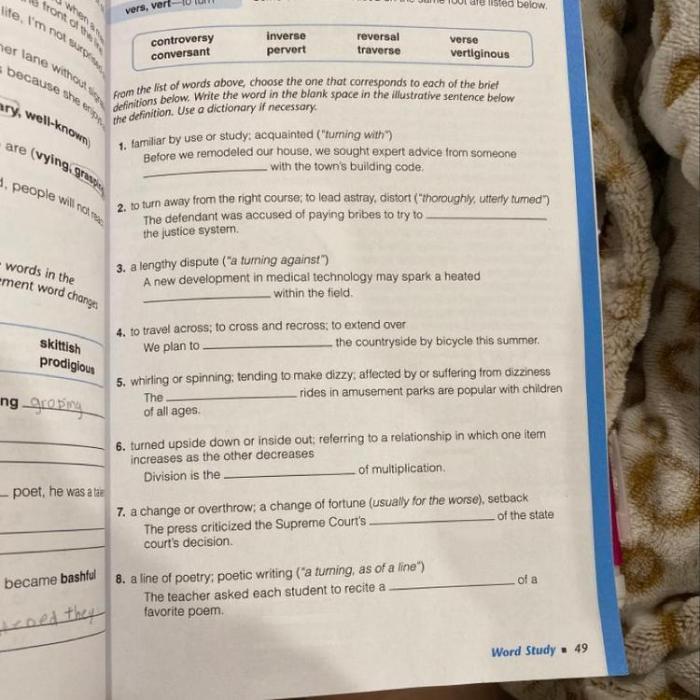Embark on a comprehensive exploration of Sadlier Vocabulary Workshop Level B Answers Unit 1, where the intricacies of vocabulary acquisition, grammar, reading comprehension, writing skills, and speaking and listening converge. This unit delves into the fundamentals of language learning, empowering learners to enhance their communication abilities.
As we delve deeper into this unit, we will uncover the key terms and strategies for effective vocabulary acquisition, unravel the nuances of grammar concepts and their applications, and analyze reading passages to extract their main ideas and supporting evidence.
Additionally, we will explore writing techniques, engage in speaking and listening activities, and provide comprehensive answers to frequently asked questions.
Vocabulary Acquisition
Vocabulary acquisition is the process of learning new words and their meanings. It is an essential skill for language learners, as it allows them to expand their vocabulary and improve their communication skills. There are a number of strategies that can be used to improve vocabulary acquisition, including:
- Reading widely and often
- Using a dictionary or thesaurus
- Playing word games
- Taking vocabulary quizzes
- Studying word roots and prefixes
Grammar and Usage
Grammar and usage refer to the rules that govern the structure of a language. These rules include things like word order, verb tense, and punctuation. Grammar and usage are important for language learners, as they allow them to produce grammatically correct sentences and avoid common errors.
The grammar concepts covered in Unit 1 include:
- Subject-verb agreement
- Verb tenses
- Noun-pronoun agreement
- Adjective and adverb placement
- Prepositions
Reading Comprehension: Sadlier Vocabulary Workshop Level B Answers Unit 1
Reading comprehension is the ability to understand the meaning of a written text. It is an essential skill for language learners, as it allows them to access information and communicate effectively in writing. The reading comprehension strategies covered in Unit 1 include:
- Previewing the text
- Identifying the main idea
- Finding supporting details
- Drawing inferences
- Summarizing the text
Writing Skills
Writing skills refer to the ability to produce clear, concise, and grammatically correct written text. Writing skills are important for language learners, as they allow them to communicate effectively in writing. The writing techniques introduced in Unit 1 include:
- Planning and organizing your writing
- Developing a topic sentence
- Supporting your ideas with evidence
- Using transitions to connect your ideas
- Proofreading and editing your work
Speaking and Listening

Speaking and listening are two essential skills for language learners. Speaking allows them to communicate their ideas and thoughts, while listening allows them to understand what others are saying. The speaking and listening skills developed in Unit 1 include:
- Pronunciation
- Intonation
- Vocabulary
- Grammar
- Conversation strategies
FAQs
What is the key focus of Sadlier Vocabulary Workshop Level B Answers Unit 1?
Sadlier Vocabulary Workshop Level B Answers Unit 1 focuses on developing students’ vocabulary, grammar, reading comprehension, writing, and speaking and listening skills.
What strategies are provided for improving vocabulary acquisition?
The unit provides strategies such as identifying root words, using context clues, and practicing spaced repetition.
What grammar concepts are covered in Unit 1?
Unit 1 covers grammar concepts such as parts of speech, sentence structure, and verb tenses.
How does the unit help students develop their reading comprehension skills?
The unit provides reading passages and exercises that help students identify main ideas, supporting details, and the author’s purpose.
What writing techniques are introduced in Unit 1?
Unit 1 introduces writing techniques such as brainstorming, outlining, and drafting.